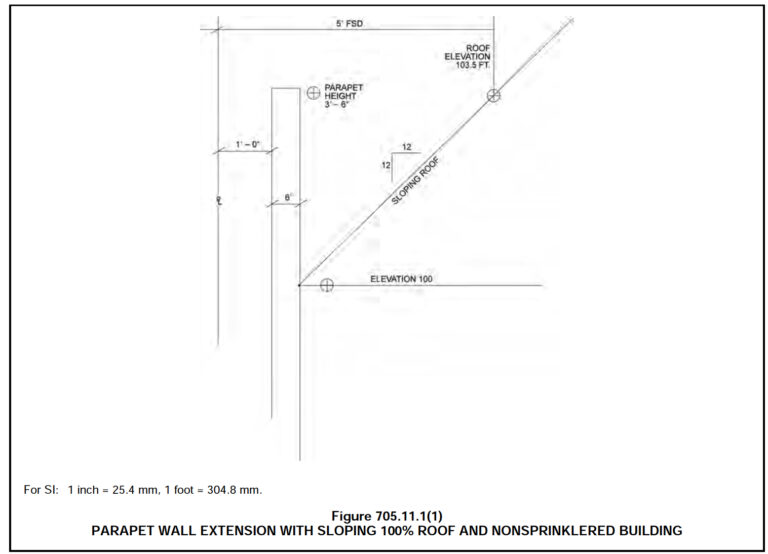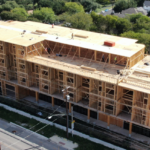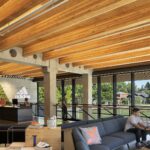Expert Tips
Construction and FRR Requirements for Parapets
International Building Code (IBC) requirements for parapets, including conditions when they do or don’t have to be constructed on all exterior walls of the building.
Parapets are aesthetic features of many buildings—typically vertical extensions of exterior walls used to create architectural elements, conceal rooftop mechanical equipment, or perform other functions. Another purpose of parapets is to impede the spread of fire from one building to another by providing a barrier to fire and radiant heat transfer if fire breaks through the roof membrane.

IBC Section 705.11 defines the requirements for parapets. As a default, the code requires that parapets be installed on all exterior walls of a building. However, there are several exceptions to this, notably when one of the following conditions exists:
- The exterior wall does not require a fire-resistance rating based solely on fire separation distance per IBC Table 602 (e.g., most multi-family, wood-frame projects would need a fire separation distance of 30 ft or more; Type VB construction with multi-family occupancies would need a fire separation distance of 10 ft or more)
- The building area is less than 1,000 sf on any given floor
- The entire roof construction is of noncombustible materials or of at least 2-hour fire resistance-rated construction (not common on most wood-frame projects)
- The building has 1-hour fire resistance-rated exterior walls that terminate at the underside of the roof sheathing, provided that:
- Roof construction that spans parallel to the exterior wall is not less than 1-hour rated for 4 ft from the interior side of the wall for Group R/U; 10 ft for other occupancies, or
- Roof construction that spans perpendicular to the exterior wall is not less than 1-hour rated for its entire span
- For either of the above cases, openings in the roof are not within 5 ft of the exterior wall for Group R/U or within 10 ft for other occupancies, and
- The entire building has a class B roof covering
- For Group R-2 or R-3 occupancies, the building is of Type III, IV or V construction and has a class C roof covering, provided that:
- The roof sheathing or deck is non-combustible or fire retardant-treated wood for a minimum of 4 ft from the exterior wall, or
- 5/8″ Type X gypsum board is installed directly to the underside of the roof sheathing or deck for a minimum distance of 4 ft from the exterior wall
- IBC Section 705.8 allows the exterior wall to have 25% or more of its openings unprotected as a function of fire separation distance
If none of the exceptions apply and a parapet is required, IBC 705.11.1 lists the construction requirements as follows.
705.11.1 Parapet construction. Parapets shall have the same fire-resistance rating as that required for the supporting wall, and on any side adjacent to a roof surface, shall have noncombustible faces for the uppermost 18 inches (457 mm), including counterflashing and coping materials. The height of the parapet shall be not less than 30 inches (762 mm) above the point where the roof surface and the wall intersect. Where the roof slopes toward a parapet at a slope greater than two units vertical in 12 units horizontal (16.7-percent slope), the parapet shall extend to the same height as any portion of the roof within a fire separation distance where protection of wall openings is required, but in no case shall the height be less than 30 inches (762 mm).
This section notes that the parapet shall have the same fire resistance as the exterior wall below it. Although it is not stated, it is common to interpret this as applying to fire rating requirements for both the inside and outside faces of the wall. For Type V construction, IBC Table 601 requires a 1-hour rating for exterior bearing walls, while no rating is required for non-bearing walls. Type III construction requires a 2-hour rating for exterior bearing walls. Fire separation distance should also be checked to determine the most restrictive requirements between Tables 601 and 602. Note that IBC 705.5 only requires exterior walls to be rated from both faces when the fire separation distance is 10 ft or less. Otherwise, the required rating only applies to the inside face of the exterior wall.
The minimum height of a parapet wall above the roof surface is 30 inches. However, when a roof slopes down toward an exterior wall and parapet with a slope greater than 2:12, further analysis is required to determine if a taller parapet is necessary.

Image Source: 2015 IBC Code Commentary
In Type III construction, exterior walls are required to be noncombustible or framed with fire retardant-treated wood (FRTW). Under these circumstances, another common question is whether parapets on Type III buildings need to be framed with FRTW. Although IBC 705.11.1 doesn’t specify the requirements for parapet construction materials, some have interpreted that code intent would imply that the use of FRTW is necessary for parapet wall construction; others have not. This is a subject that should be discussed with the Authority Having Jurisdiction regarding their interpretation and requirements. The code commentary to section 705.11.1 does appear to require that the parapet be constructed of the same materials as the exterior wall:
Parapet wall construction shall be of combustible or noncombustible material depending on the exterior wall requirements of the type of construction and shall be of fire resistance-rated construction as required for the exterior wall.
Under certain circumstances, parapets may not be required by code (using one of the exceptions noted above) but are still installed on a building to serve aesthetic functions. In this case, a common question is whether or not the parapet needs to follow the fire-resistance rating and construction requirements of IBC 705.11. For this scenario, some designers have successfully designed and constructed parapets without a fire-resistance rating (even when the exterior wall below requires one) by using the rationale that the parapet is similar to a roof member/roof extension or an exterior wall projection as opposed to an exterior wall member. This is based on the fact that the parapet is not required by code and, therefore, is not required to provide fire containment. This is another topic that should be discussed with the local building official to determine their interpretation and requirements, but this idea does appear to meet the code’s intent as noted in the code commentary to IBC 705.6 when discussing fire-resistance continuity requirements of exterior walls:
When parapet walls are not required, the exterior wall for fire-resistant rating purposes stops at the roof/ceiling construction.


